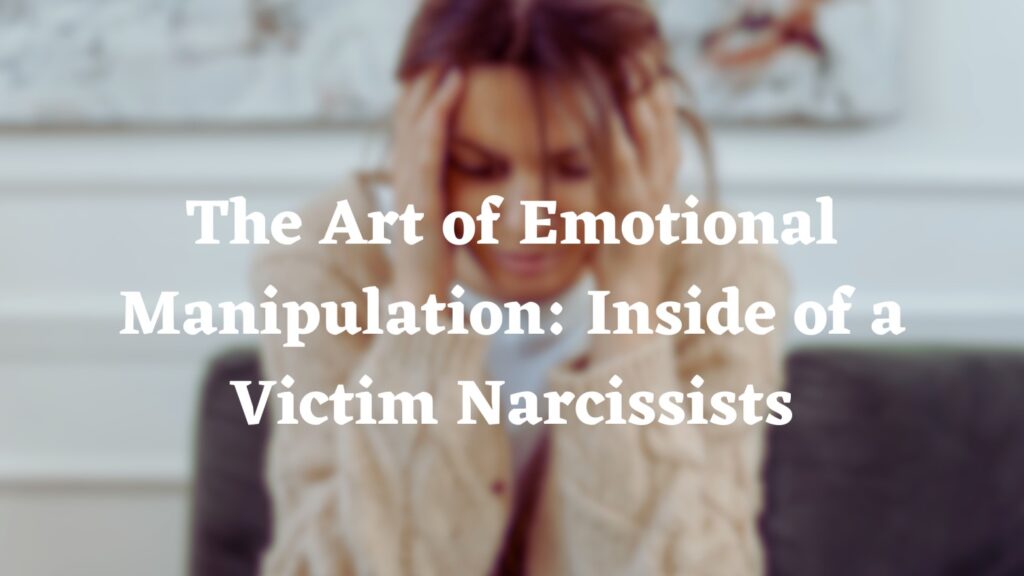
Have you ever come across someone who seems to take any problem very seriously? Have you ever wondered why they present themselves as the only ones experiencing difficulties? Step into the world of the victim narcissist, where self-pity reigns supreme and placing blame is an artistic endeavor. Some may be fooled by theatrics, but behind the surface is a twisted network of behavior and psychology that is both interesting and annoying. Now this is what is called victim narcissism, which is frequently connected to narcissistic personality disorder (NPD).
Unpacking Victim Narcissism
Understanding victim narcissism makes us see how some people often act like victims on purpose. Furthermore, research says these types of people can be manipulative, wanting attention and sympathy by always playing the victim.
According to psychologist Dr. Ramani Durvasula, “Victim narcissists constantly need people to feel sorry for them and say nice things to them.”
Victim narcissists may :
Exaggerate their hardships,
Fabricate stories of victimization, or
Blame others for their misfortunes to garner sympathy.
A person showing victim narcissism could reflect characteristics of Narcissistic Personality Disorder (NPD). Indeed this isn’t just about fancy terms; it’s about grasping why some people always play the victim.
Let’s dig into NPD and how it ties to a victim narcissist.
Exploring the Depths of NPD
Now, let’s take a closer look at Narcissistic Personality Disorder (NPD). This condition lies at the heart of the complicated web of victim narcissism. People with NPD often demonstrate an exaggerated sense of self-importance, constantly seeking admiration and validation while showing little empathy for others. Their interactions are often marked by manipulation and exploitation, straining relationships and causing distress to those around them.
Relationships—personal or professional—can be significantly impacted by NPD. Because of their egocentric inclinations and lack of empathy, people with NPD frequently struggle to maintain positive relationships with others. Family members have frequent arguments and misunderstandings that exhaust them emotionally and make them feel unnoticed.
Victim Narcissist in Family
A victim narcissist within a family dynamic entails a member habitually adopting a victim role to garner attention, sympathy, and validation from others. Below are examples illustrating how this behavior may manifest:
- Persistent Blame-Shifting: A family member consistently deflects blame onto others for their own problems or mistakes, refusing to acknowledge their responsibility. For instance, they might fault their sibling for damaging a household item, despite being the one who mishandled it.
- Exaggerated Hardships: They frequently overstate their challenges or difficulties to elicit sympathy and support from family members. For instance, they may dramatize minor inconveniences, portraying them as major crises to evoke empathy.
- Attention-Seeking Behavior: Often a victim narcissist continuously craves attention and validation from family members, often resorting to dramatic displays of emotion or self-pity. They might monopolize conversations with stories of their suffering or constantly seek reassurance and admiration.
- Manipulative Guilt-Tripping: Employing guilt tactics to manipulate family members into meeting their needs or fulfilling their desires. For example, they might guilt-trip a parent into providing financial support by emphasizing their sacrifices for the family.
- Playing the Martyr: They depict themselves as selfless martyrs who sacrifice for the family’s welfare, despite evidence to the contrary. They may claim to have forsaken their dreams and ambitions for the family’s sake, even if they haven’t made significant sacrifices.
- Seeking Special Treatment: They anticipate special treatment or exemptions from rules and responsibilities due to their perceived victimization. For instance, they may demand preferential treatment from family members, citing their past hardships as justification.
- Refusal to Accept Help: Despite seeking sympathy and validation, still a victim narcissist rejects genuine offers of assistance or support from family members to uphold their victim narrative. For example, they might refuse advice or aid, insisting that no one truly understands their struggles.
Victim narcissism in the outside world
Victim narcissism in the outside world refers to individuals who habitually portray themselves as victims in various social, professional, or public settings of course to gain attention, sympathy, and validation. Here are examples illustrating how a victim narcissist might manifest outside the family:
- Workplace Dynamics: Consistently blames colleagues or superiors for failures or setbacks, deflecting responsibility for their performance. They may also exaggerate the challenges they face in their role to garner sympathy and avoid accountability.
- Social Interactions: In social settings, constantly present themselves as the victim of circumstances, seeking validation and support from friends or acquaintances. Undoubtedly they may fabricate or embellish stories of personal hardship to evoke empathy and attention.
- Online Behavior: A Victim narcissist regularly posts about their struggles and challenges online, to demonstrate themselves as a victim of injustice or mistreatment. They may seek validation through likes, comments, and shares, exploiting their online presence for sympathy and attention.
- Community Engagement: Within community or activist groups, an individual may adopt a victim narrative to garner support for their cause or agenda. They do this often by portraying themselves as oppressed or marginalized. No doubt this helps them to leverage their victimhood to rally others to their side and gain influence.
- Customer Service Interactions: It’s not easy to sell something to a person showing victim narcissism. Frequently they complain and demand compensation for perceived slights or inconveniences. They leverage their status as a victim to extract special treatment or discounts. In addition, a victim narcissist may escalate minor issues into major grievances to assert control over service providers.
- Legal Proceedings: In legal disputes or negotiations, a party may exaggerate their suffering or victimization to sway the judgment or sympathy of the court or jury. They may manipulate facts or emotions to cast themselves as the innocent victim in the eyes of the law.
- Public Advocacy: In any case a public figure or activist may exploit their victim status to gain attention and support for their cause, using their platform to amplify their grievances and solicit sympathy from the public. They may present themselves as champions of justice, rallying others to their cause through emotional appeals.
Signs of victim narcissism:
We’ll examine the main indicators of victim narcissism, uncovering the motivations that drive the behavior pattern of a victim narcissist.
- Constant Self-Pity: Individuals with victim narcissism often engage in excessive self-pity, constantly portraying themselves as victims of circumstances or other people’s actions.
- Externalizing Blame: They habitually blame others for their misfortunes, certainly refusing to take responsibility for their actions or decisions.
- Seeking Sympathy and Validation: They actively seek sympathy, attention, and validation from others by emphasizing their hardships and struggles.
- Exaggerating Hardships: They may exaggerate or embellish their difficulties to garner more sympathy and support from those around them.
- Playing the Victim Card: They manipulate situations and conversations to cast themselves as victims, using their perceived suffering to gain advantage or control.
- Refusal to Accept Responsibility: They resist acknowledging their role in conflicts or problems. On the other hand, they blame others to maintain their victim narrative.
- Emotional Manipulation: They use emotional manipulation tactics. Guilt-tripping or gaslighting is often used to control and manipulate others into meeting their needs.
- Victim Complex: They portray themselves as selfless martyrs who sacrifice their well-being for the sake of others, even if their actions suggest otherwise.
- Attention-Seeking Behavior: They crave constant attention and validation from others. The motive is to elicit sympathy by dramatic displays of emotion or self-pity.
- Lack of Empathy: Despite seeking empathy and validation themselves, they often lack empathy towards others’ struggles or hardships. No doubt a victim narcissist focuses solely on his own perceived victimhood.
Why narcissists play the victim card
- Attention-Seeking: By presenting themselves as victims, individuals draw attention to their struggles and hardships, so that to make sure that others focus on them and their needs.
- Sympathy and Validation: Playing the victim card allows individuals to elicit sympathy and validation from others, fulfilling their deep-seated need for reassurance and affirmation.
- Manipulation: By presenting themselves as victims, individuals can manipulate others’ emotions and behaviors, gaining control over situations and relationships.
- Avoiding Accountability: Playing the victim card shifts blame onto others, thus allowing individuals to evade responsibility for their actions or decisions.
- Maintaining a Sense of Superiority: Some individuals may play the victim card to position themselves as morally superior to others. They do this to reinforce their belief in their entitlement to attention and sympathy.
- Emotional Satisfaction: Victimhood can provide individuals with a sense of emotional satisfaction, as they receive the sympathy and support they crave from others.
- Justification for Behavior: Surprisingly by casting themselves as victims, victim narcissist may justify their actions or decisions, portraying themselves as innocent victims of circumstances beyond their control.
- Coping Mechanism: For some individuals, playing the victim card serves as a coping mechanism for dealing with challenges or setbacks.
Maintaining Illusions: Strategies of Victim Narcissist
Victim narcissists often employ defense mechanisms to protect their fragile self-esteem and cope with feelings of inadequacy. Here are some common defense mechanisms used by victim narcissists:
- Projection: Victim narcissists may project their own flaws, insecurities, or negative traits onto others. By attributing their shortcomings to external sources, they can avoid facing uncomfortable truths about themselves.
- Denial: When confronted with evidence that contradicts their victim’s narrative or challenges their self-image, victim narcissists without a doubt deny or minimize the significance of the information. This allows them to maintain their illusion of victimhood and avoid acknowledging their role in conflicts or problems.
- Blame-Shifting: A Victim narcissist often shifts blame onto others, refusing to take responsibility for their actions or decisions. They may deflect criticism by pointing fingers at those they perceive as aggressors or oppressors furthermore painting themselves as innocent victims of extreme forces.
- Justification: To justify their victimhood and garner sympathy from others, victim narcissists may distort facts or selectively present information in a way that supports their narrative. They may exaggerate their hardships or rewrite history to paint themselves as martyrs or heroes in their own stories.
- Rationalization: It’s not new for a victim narcissist to rationalize behavior or decisions. This is done by finding seemingly logical explanations or excuses in order to justify their actions. This allows them to reconcile their self-image as victims with their actions, alleviating cognitive dissonance and preserving their sense of moral superiority.
- Playing the Martyr: By adopting the role of the martyr, victim narcissists elicit sympathy and admiration from others. They do so by exaggerating their sacrifices or portraying themselves as selflessly enduring suffering for the sake of others, enhancing their self-image, and seeking validation from those around them.
- Gaslighting: In severe instances, victim narcissists might employ gaslighting, leading others to doubt their own perceptions, memories, and sanity. Through distorting reality and planting seeds of uncertainty, they retain dominance over their victims and diminish their credibility.
Protecting Yourself from Victim Narcissist
Protecting yourself from a victim narcissist within your family dynamic is essential to maintain your emotional well-being. Here are some strategies to consider
1. Establish Clear Boundaries:
- Define your boundaries: Clearly articulate what behaviors are acceptable and unacceptable to you.
- Communicate assertively: Express your boundaries directly and firmly to the narcissist.
- Enforce boundaries: Be prepared to enforce consequences if your boundaries are violated, such as limiting contact or ending conversations.
2. Recognize Manipulative Behavior:
- Identify tactics: Learn to recognize manipulative tactics commonly used by a victim narcissist, such as guilt-tripping, gaslighting, and playing the martyr.
- Trust your instincts: Pay attention to your feelings and intuition when interacting with the narcissist. If something feels off, it likely is.
3. Maintain Self-Care:
- Place importance on your well-being: Make self-care a priority by participating in activities that nurture your physical, emotional, and mental health.
- Seek assistance: Connect with understanding friends, family members, or a therapist for validation and guidance.
- Allocate time for yourself: Reserve moments for activities that bring you happiness and tranquility, thus enabling you to rejuvenate and uphold your resilience.
4. Establish Healthy Communication:
- Remain poised and collected: Keeping composure when engaging with the narcissist, steering clear of emotional responses that could escalate tensions.
- Employ “I” statements: Articulate your emotions and requirements using “I” statements to assert yourself without assigning blame.
- Engage in active listening: Listen attentively to the narcissist’s concerns while upholding boundaries to prevent manipulation and maintain your independence.
5. Set Realistic Expectations:
- Accept limitations: Recognize that you cannot change the behavior or personality of a victim narcissist.
- Manage your expectations: Adjust your expectations of the narcissist’s capabilities and willingness to change. Instead, you should focus on managing your responses and boundaries.
6. Create Emotional Distance:
- Limit exposure: Minimize contact with a victim narcissist when possible, especially during times of heightened manipulation or conflict.
- Focus on positive relationships: Cultivate relationships with supportive family members or friends who respect your boundaries and provide validation.
7. Seek Professional Help if Needed:
- Consider therapy: Individual therapy can provide you with coping strategies, validation, and support in navigating your relationship with the narcissist.
- Family therapy: Consider family therapy to address communication issues and set boundaries within the family unit.
Conclusion
In wrapping up, protecting yourself from a victim narcissist is like building a strong shield around your heart. It’s about setting clear rules, taking care of yourself, and staying true to what you believe in, even when things get tough. By doing this, you’re standing up for yourself and making sure your feelings are respected. Remember, you’re worthy of love and happiness, no matter what. So, keep shining bright and holding on to your strength, even in the face of family challenges.
Share this content:




